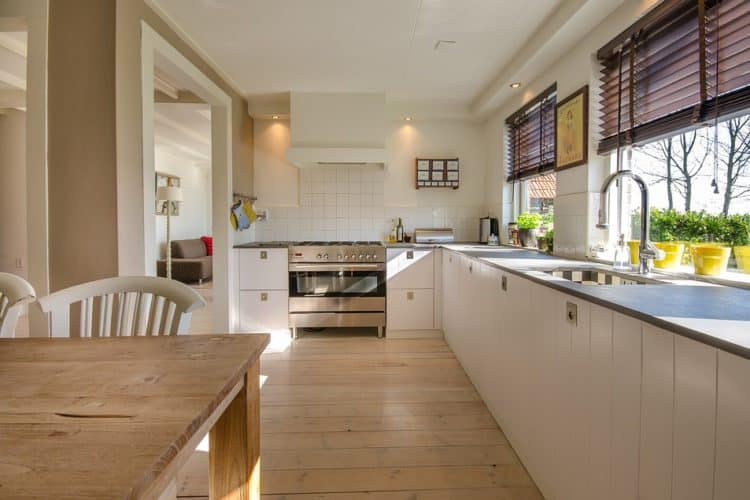
What is an L-Shaped Kitchen?
Are you looking to maximize the space in your kitchen while maintaining an open design? You may want to consider an L-shaped design when you’re remodeling your kitchen. This is one of the most popular kitchen designs today because this type of layout offers many advantages, especially for homeowners who are looking for an open design that maximizes space.
We will use this blog to review the main characteristics of this kitchen style, explain its advantages and disadvantages, and compare L-shaped designs to other kitchen layouts. We’ll even provide some ideas and information about how to design the kitchen of your dreams. By the time you finish reading, you will be an L-shape expert.
L-Shaped Kitchen 101: What is it?
As the name suggests, an L-shaped kitchen is in the shape of the letter L. Generally, this type of kitchen layout will feature appliances for cooking and cleaning on one side of the L and space for storage on the other.
In order to support this design, you must have at least one wall. This wall will include cabinets and other important kitchen features such as the sink and stove. This section makes up one side of the L.
As for the other side, the adjacent wall or half-wall will feature counter space, which allows you to spread out your workspace while you’re cooking and baking. In some cases, this side of the kitchen will be open to the living room or dining room. This means that there are no overhead kitchen cabinets. Many people love this design because it creates the illusion of having more space and keeps the kitchen from feeling closed off.
Many L-shaped kitchens will also incorporate an island into the design. This feature provides extra food preparation and storage space, making it an attractive addition to any kitchen.
Together, all of the basic features of an L-shaped kitchen come together to create a functional and attractive kitchen space that is ideal for cooking, eating, and socializing.
The Advantages of an L-Shaped Kitchen
The design of an L-shaped kitchen allows you to create an open floor plan, which can make it easier to move around your home. It also gives you the option to open your kitchen up to other living areas, including the living room, dining room and breakfast nook. The open flow provides a modern feel and is what many people are seeking in their cooking area and kitchen layouts.
The versatility of L-shape kitchen designs is another benefit. The style lends itself to many different layouts, ranging from ones that are more family-oriented to options that are perfect for entertaining. You can also have entirely different looks for your kitchen, depending on your cabinets, backsplash, appliances, and hardware. From sleek and modern, to cozy and traditional, you can make your kitchen’s interior design your own by selecting the colors, textures, and patterns that appeal to you.
Homeowners who spend a great deal of time cooking praise the L-shaped kitchen for maintaining the valuable kitchen work triangle. Wondering what this mysterious work triangle is? It means that the kitchen arrangement creates an efficient relationship between three of the most critical features in the space: the stove, sink, and refrigerator.
Most of the time, the external wall of an L-shape kitchen design will feature the cooking and cleaning appliances, including the sink. This arrangement is ideal because it is a very efficient way to make the plumbing more accessible – and easier to hide in the cabinets.
Many people also praise the L-shaped kitchen because the area allows them to easily accommodate an island or breakfast bar. This addition can provide more storage, eating space, and room for meal preparation. Not only that, it can be a stylish and aesthetically pleasing option for homeowners.
The Disadvantages of an L-Shaped Kitchen
L-shaped kitchens are known for using two adjacent walls to create the unique and versatile shape. While some of these kitchens place upper and lower cabinets on both sides of the L, some designs only feature lower cabinets and an open countertop.
This type of layout opens up the kitchen to a neighboring room and provides a more-open flow to your home, but it has one distinct disadvantage. You lose the extra storage that is found in the upper cabinets.
Another disadvantage relates to a specific-type of L-shaped kitchen: one with a sink in the kitchen island. Although this layout can make the kitchen more efficient by adding more space for cleaning and food prep, it often requires reconfiguration of the plumbing. Doing this can make your kitchen remodel more expensive, but many homeowners find that the added efficiency is worth the cost.
The amount of counter space can sometimes be a disadvantage in an L-shaped kitchen. The vast countertops may be too much from a visual perspective and take away precious storage space, especially in a smaller kitchen. To solve this problem, you can incorporate hutch-style cabinets on the countertop. Not only does this improve the appearance of the kitchen by breaking up the counter space outside of the kitchen triangle, but it also creates additional storage.
Comparing L-Shaped Kitchens to Other Designs
Before you commit to an L-shaped kitchen in your home, you may be wondering if another layout would be a better fit for you. Here are some other popular kitchen designs and how they compare to the L-shape.
The one-wall kitchen is common in apartments and small homes. It keeps all of the appliances, cabinets, and countertops on one wall. Although this design has everything within reach of the chef, it can be short on counter space because the appliances take up much of the space. However, depending on the size of your space, you may be able to add more countertops by installing an island.
The galley kitchen is one of the most efficient kitchen designs for basic cooking. Named after the kitchen of a ship or airplane, this layout makes excellent use of a small space. In fact, many restaurants and commercial kitchens use this layout, which consists of a long narrow space that includes appliances and countertops.
Although a galley kitchen is perfect for efficiency, it has some disadvantages in a home. It doesn’t allow you to have a dining area in the space and it can limit the cook’s interaction with their guests and family. For people who are fans of the L-shaped kitchen’s open design, this style can feel too confined, even when both sides of it are open.
Another kitchen layout that features an alphabet letter in the name is the U-shaped kitchen. This design is efficient for one cook because it features cabinets, countertops, and appliances on three adjoining kitchen walls. It can be open on the fourth side of the room or closed with another wall.
One of the biggest complaints about the U-shaped kitchen is the lack of room for a dining table and chairs. Although this can be addressed by adding an island in the center of the room, many older kitchens don’t have room for one. Industry guidelines recommend that there be three and a half feet between the kitchen island and the cabinets and appliances. Because older kitchens were not built to include islands, they lack this valuable space.
Questions to Ask When Designing an L-Shaped Kitchen
Installing an L-shaped kitchen can be a great way to maximize the space in your kitchen and improve the appearance of your home. But before you commit to this design, you’ll want to ask yourself a few important questions.
How Will You Use Your Kitchen?
An L-shaped kitchen can meet a wide variety of lifestyles and needs. The layout is perfect for entertaining and households with multiple chefs who will be cooking at the same time. It’s also great for families because children can sit at the kitchen island or counter to do their homework while their parents prepare dinner.
Although this eat-in kitchen is a great option for just about every lifestyle, it’s important to think about how you will be using the room. If you’re passionate about entertaining, you’ll want to create a more open concept, while you should focus on appliances and counter space if you’re a chef. Customizing your kitchen to meet your lifestyle and needs will help you create a space that will make you and your family happy for years to come.
How Big Is Your Space?
An L-shaped design can work in kitchens of most sizes, but the smallest spaces may benefit from another layout. A galley or U-shaped kitchen may be better options to maximize space in a tiny kitchen. But you can sometimes make an L-shape work in a smaller space. You might just have to make some sacrifices. For example, you probably won’t be able to incorporate an island in your L-shape kitchen if your room is on the small side.
How Big Is the Space in the Middle of the Room?
If you have the space and want to include an island in your kitchen, you will want to consider the space in the center of the room. You should think about the size of the area. If it’s on the smaller side, it might be more difficult to include a sink in the center island.
The configuration of the space should also be a consideration. Although most people think of kitchen islands as a square, a rectangular one might be a better way to make the most of the space in your room.
What Are Your Storage Needs?
Each person has unique storage needs. While one may love to use different gadgets in the kitchen – and need somewhere to store all of them, another person may only use the basic essentials when they prepare meals. You should think about how much storage space you need when you’re designing your kitchen. This is especially important if you have many kitchen gadgets and accessories to organize.
If you’re someone who has a wealth of pots and pans, you may want to consider adding a pot rack to free up space in your cabinets. This addition can be functional and attractive over an island in the center of the room. If you’re someone who would prefer to keep your clutter hidden, think about maximizing your wall cabinets. This might mean that you need two full walls in your L-shaped design, but it can make a huge difference from a storage perspective.
Do You Have a Doorway on One of the Walls?
You can still have an L-shaped kitchen, even if one of the walls has a doorway in it. This is a broken L-shape, and it provides a wonderful opportunity to try unique designs. The height of the doorway allows you to add a tall wall of cabinets on one leg of the L. You can also use the break in the L to play with using a variety of materials for your countertops.
In addition to these benefits, you can also use the broken L-shape to create distinct workstations for food preparation, cooking, and cleanup. This is ideal if you have multiple cooks working in the same space.
Do You Have Any Special Considerations?
When you’re remodeling your kitchen, you want it to be right for you. Now is the time to think about what would make your life easier. Are you left-handed? If so, you may want to configure your kitchen differently than a right-handed cook would. Do you or a family member use a wheelchair? If yes, you may want to ask an expert for ways to make your kitchen more accessible. You can make so many modifications to make your kitchen work better for you.
Now that you know the ins and outs of L-shaped kitchens, you will be able to decide whether this layout is the right fit for your home and family.
For more ideas and information about L-shaped kitchen design, check out our blog post on how to make the most of your L-shaped kitchen.











